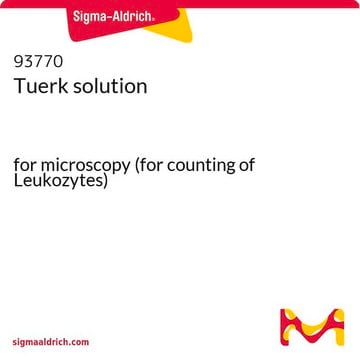Tuerk's solution is not suitable for counting thrombocytes/platelets. It is advisable to use phase contrast microscopy for platelet counting, as Tuerk's solution may destroy platelets.
1.09277
Tuerk′s Solution
for leukocyte counting
Synonym(s):
Acetic acid gentian violet solution
Select a Size
About This Item
Recommended Products
Quality Level
form
liquid
IVD
for in vitro diagnostic use
technique(s)
microbe id | staining: suitable
pH
2.5-3.5
density
1.00 g/cm3 at 20 °C
application(s)
clinical testing
diagnostic assay manufacturing
hematology
histology
storage temp.
15-25°C
Related Categories
General description
The basis of all counting methods is the dilution and preparation of a blood sample of known volume. The erythrocytes are hemolyzed by the acetic acid present in Tuerk′s solution and the leukocyte nuclei are stained blue-violet by the dye. The required cell type in a defined volume is counted and the number of cells per microliter of blood is then calculated.
The 100ml bottle of Tuerks solution will provide approx. 10 applications. Tuerk′s solution is an IVD product and CE registered.For more details, please see instructions for use (IFU).
Storage Class
12 - Non Combustible Liquids
wgk_germany
WGK 1
flash_point_f
Not applicable
flash_point_c
Not applicable
Certificates of Analysis (COA)
Search for Certificates of Analysis (COA) by entering the products Lot/Batch Number. Lot and Batch Numbers can be found on a product’s label following the words ‘Lot’ or ‘Batch’.
Already Own This Product?
Find documentation for the products that you have recently purchased in the Document Library.
Customers Also Viewed
-
Can Tuerk's solution stain platelets/thrombocytes? Is there any other better stain for counting platelets?
1 answer-
Helpful?
-
-
what is the concentration of Turks solution
1 answer-
The concentration of the Turks solution is not determined.
Helpful?
-
-
Can I count PBMC with Turk Solution? Or what are the best option for PBMC counting? and another question Can Turk stain Thrombocytes?
1 answer-
Tuerk's Solution is primarily used for counting the total white cells present in a peripheral blood specimen, including PBMCs (lymphocytes and monocytes).
For accurate counting of PBMCs, the most common approach is to use flow cytometry or hemocytometers. Hematology labs will typically have dedicated cell counters that will also count white blood cells and also classify the percentage of each type of white blood cell found in the blood specimen. Alternatively, instruments, such as the Scepter™ cell counter, will differentiate PBMCs based on size.See the link below to review an application note that may be of interest:
https://www.sigmaaldrich.com/deepweb/assets/sigmaaldrich/product/documents/326/775/an3311en-ms.pdfTuerk's solution is not routinely used for counting thrombocytes or platelets. Although some platelets may show some staining, there will be platelets that remain unstained. Most labs that count platelets manually will use ammonium oxalate to lyse the red blood cells and then use a phase hemacytometer and a phase (contrast) microscope.
Helpful?
-
Active Filters
Our team of scientists has experience in all areas of research including Life Science, Material Science, Chemical Synthesis, Chromatography, Analytical and many others.
Contact Technical Service











